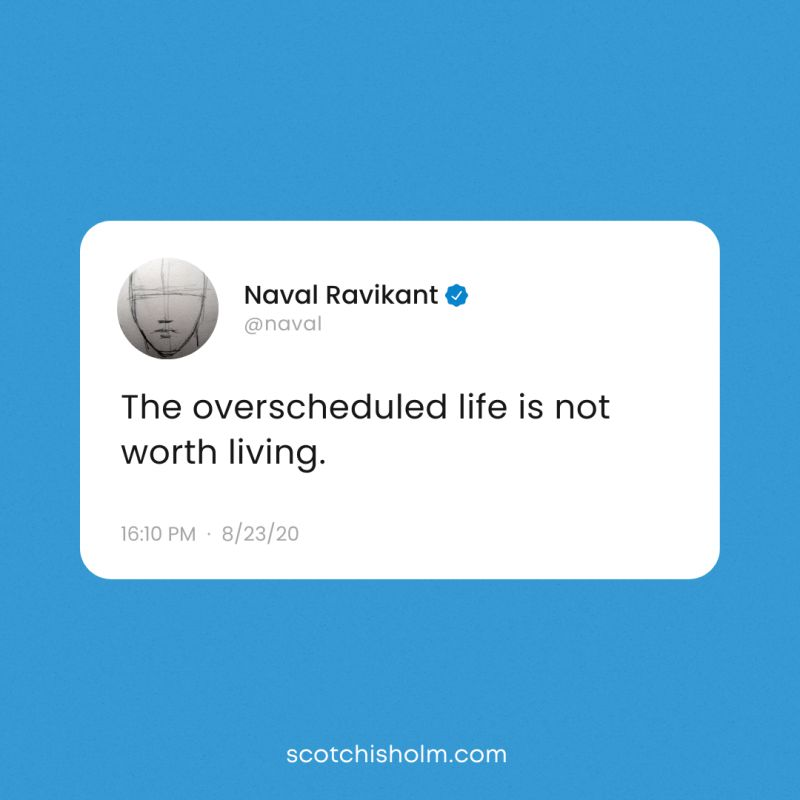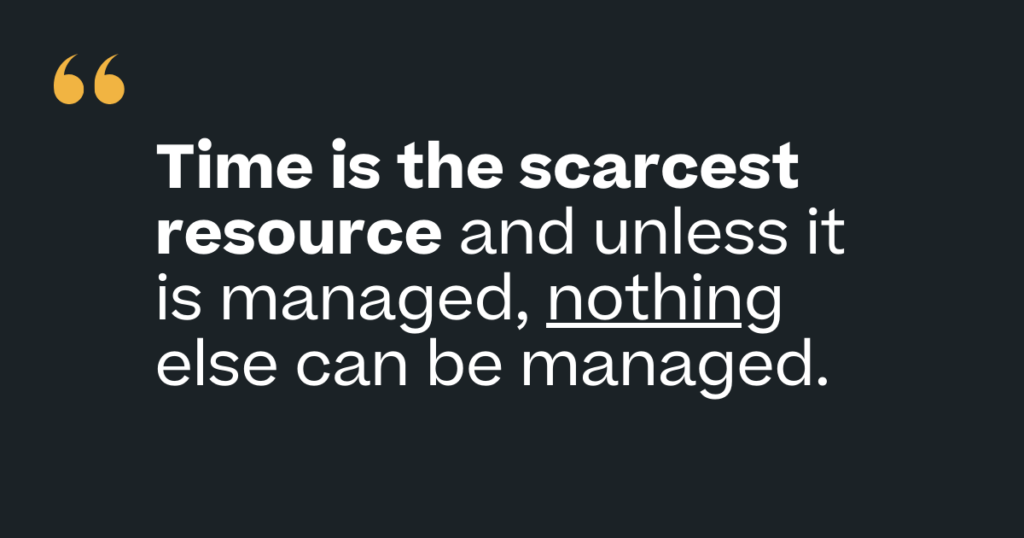
As a leader, your time is your most valuable asset. So, the difference between good and great leadership is how you use your time.
That makes your calendar one of your most powerful tools.
But it can also be your biggest enemy if not managed carefully. After nearly 20 years leading companies, I’ve learned the hard way that an overloaded, scattershot calendar is a recipe for disaster. It leads to burnout, lack of focus, and a team that’s constantly playing catch-up.
As Naval once said:

But it doesn’t have to be this way. By implementing a few calendar rules, you can turn your schedule from a chaotic mess into a well-oiled machine.
Here are the 5 rules I live by to keep my calendar (and my sanity) in check:
Mornings are prime time for deep work and strategic thinking. It’s when your mind is fresh, your energy is high, and distractions are minimal.
Yet too many leaders waste this precious time on meetings and emails. They start their days in reactive mode and never fully gain control.
That’s why my first rule is no meetings before 10 AM, no matter what. I block off the first two hours of every day for focused, uninterrupted work on my top priorities. No exceptions.
This simple rule has been a game-changer for me. It ensures I make progress on what matters most before the chaos of the day takes over.
Don’t get me wrong. There will be the occasional emergency that requires an early morning meeting. But those should be the exception, not the rule. Protect your mornings fiercely. Use those crucial first hours to set your intentions for the day, review your goals, and make headway on your most critical tasks. This habit alone can dramatically increase your productivity and sense of control over your day.
Bottom line: If you start with a slew of meetings in the morning, you’re immediately in reactive mode. You’re responding to other people’s agendas instead of tackling your own agenda.
Back-to-back meetings are the enemy of high energy.
When you jump from one meeting to the next without a break, your mind doesn’t have time to process and recharge. You end up carrying mental baggage from one conversation to another, which can lead to confusion, forgetfulness, and poor decision-making.
The fix is simple: schedule buffer time between meetings. Even just 15-30 minutes can make a world of difference. By giving yourself some breathing room, you’ll show up to each meeting refreshed and ready to engage. You’ll be more present, more focused, and more effective in your communications.
But be intentional about how you spend these moments. Stand up, stretch, and get your blood flowing. Use this time to:
Give your brain a real break from the constant stimulation of screens and conversation.
These small pockets of rest and recovery throughout the day can have a big impact on your overall well-being and performance as a leader. Treat them as non-negotiable.
As the week progresses, meetings tend to pile up and butt out time for focused work. By Friday, it can feel like you’ve spent the entire week in conference rooms without making real progress on your own projects and goals.
To combat this, I recommend implementing ‘Creative Fridays’ – a day reserved for deep work and creativity. No meetings, no distractions, just uninterrupted time to think, strategize, and create.
This is easier said than done, especially in a fast-paced startup environment where fires are always burning. But leaders must carve out this time for big-picture thinking and innovation. Use it to:
Protect your Creative Fridays as much as possible, even if it means setting boundaries with your team and stakeholders.
The key is to communicate the importance of this focused time upfront. Let your team know what you use Friday’s for and why that’s valuable to you and the company. Encourage them to adopt a similar practice if possible – even a half day works wonders!
Most meetings are notorious time-suckers. It’s where productivity goes to die.
In fact, research shows the average employee wastes 31 hours in unproductive meetings per month. But when you’re the leader, those numbers can easily double or triple. You’re the one everyone wants a meeting with!
As a leader, it’s your job to protect your team’s time and energy. That means being ruthless about which meetings make the cut. Before adding a meeting to the calendar, ask yourself:
If the answer to any of these is no, cut the meeting. It’s that simple. Your team will thank you for giving them back precious time to focus on work that moves the needle.
Not all meetings are bad, though. You should include a few high-impact, high-leverage meetings like:
By nailing these three meetings, you will eliminate the need for so many other wasteful meetings that get put on your calendar.
But remember – any type of meeting can be run poorly. So always make sure every meeting is:
And dive into my other posts on how to run these meetings like a pro: here, here, and here.
We’ve all been in those meetings where half the room is wondering why they’re there. Attendees are scrolling on their phones, zoning out, or multitasking because the discussion doesn’t really require their input.
As a general rule, aim to keep meetings to 7 people or fewer. Jeff Bezos famously uses the ‘two pizza rule’—never have a meeting where two pizzas couldn’t feed the entire group. The idea is that with fewer people in the room, conversations are more focused, decisions are made faster, and accountability is clearer.
But small meetings aren’t just about efficiency—they also lead to better ideas and solutions.
In a large meeting, many people may be hesitant to speak up or challenge the status quo. But in a small group of key stakeholders, everyone feels a responsibility to contribute their unique perspective. Debate is welcomed, leading to more robust strategy and problem-solving.
Of course, there will be times when you need a larger meeting. A great example is the all-hands meeting that literally involves everyone on the team or company.
But for most meetings, less is more. Keep the invite list tight and only include those whose input is necessary.
—
Peter Drucker once wrote:

I agree.
Abiding by these 5 rules has been a game-changer for me. My days are more focused, my energy is higher, and I’m able to make more progress on the things that matter most.
But the key is adaptability. Don’t beat yourself up if a rule is broken out of necessity once in a while. Shit happens. The business will need you sometimes, and that’s perfectly OK.
My goal is to abide by these rules at least 90% of the time. So I give myself a 10% buffer for emergencies, other priorities, interesting meetings I actually want to take, etc.
Over time, these rules will become habits and feel automatic. It’s an amazing feeling to have your calendar working for you—instead of against you!
Are you a founder, executive, or manager? I’d love to support your professional growth.
Here are three ways:
Join 100,000+ leaders getting the blueprint to go from $0 to $100M.
If you watch one thing this week, this should be it 👇 Ever feel like you’re working your ass off, but not making any real progress? It happens to the best of us. In the...
Founders, Leadership | May 17, 2024
It’s all about incentive alignment… Most companies screw up compensation design. They struggle to balance base pay, bonus pay, and sales commissions – either making things too complex (you need a PHD to understand your...
Founders | April 5, 2024
Raising money is like walking through a minefield. As a founder and CEO for nearly 20 years, I’ve raised hundreds of millions from startup investors. I’ve heard it all—the good, the bad, and the downright...
I'd love to learn more about you to better customize the tips I send, ensuring they are as relevant and helpful as possible.


Hi, I’m Scot — Join 100,000+ leaders getting
the blueprint to go from $0 to $100M.